Aviva PLC: Developing Individuals, Teams, and Organizational Report
VerifiedAdded on 2020/07/23
|18
|4927
|36
Report
AI Summary
This report delves into the multifaceted aspects of developing individuals, teams, and organizations, with a specific focus on the practices of Aviva PLC. It begins by outlining the essential knowledge, skills, and behaviors (KSB) required of HR professionals, emphasizing the importance of understanding HR fundamentals, employment environments, organizational culture, and compliance policies. The report then evaluates a personal skills audit for an employee, Jane Cambridge, highlighting areas for improvement in communication, IT skills, and problem-solving. A comprehensive professional development plan is presented, detailing team goals, activities, resource requirements, and timelines for achieving objectives. The report further examines the interplay between organizational and individual learning, training, and development, underscoring the need for continuous professional development to sustain business performance. It explores the contribution of High-Performance Work (HPW) to employee engagement and competitive advantage, as well as various performance management strategies to foster a high-performance culture. The report concludes by summarizing key findings and recommendations for fostering individual, team, and organizational growth within a corporate setting, emphasizing the critical role of HR in driving these developments.
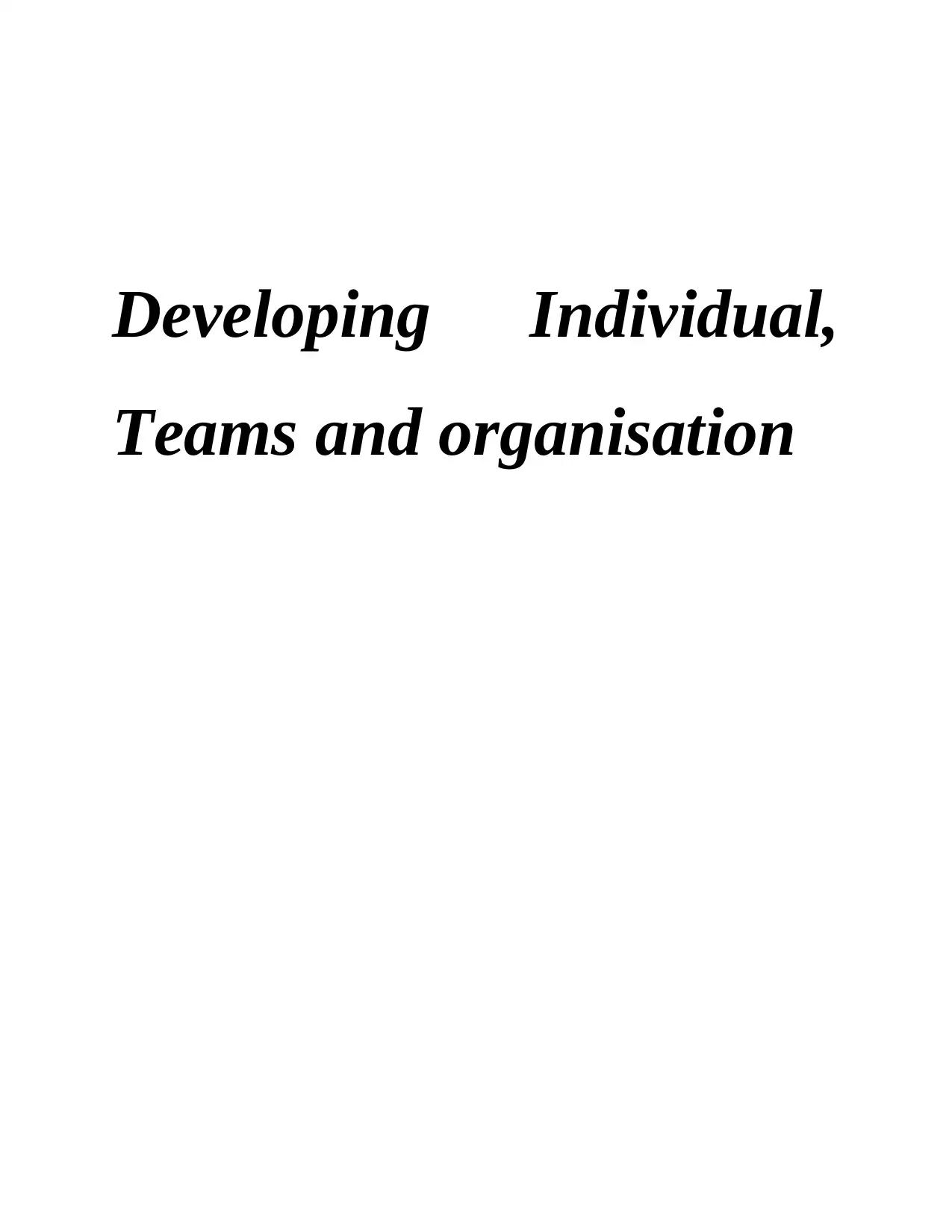
Developing Individual,
Teams and organisation
Teams and organisation
Paraphrase This Document
Need a fresh take? Get an instant paraphrase of this document with our AI Paraphraser
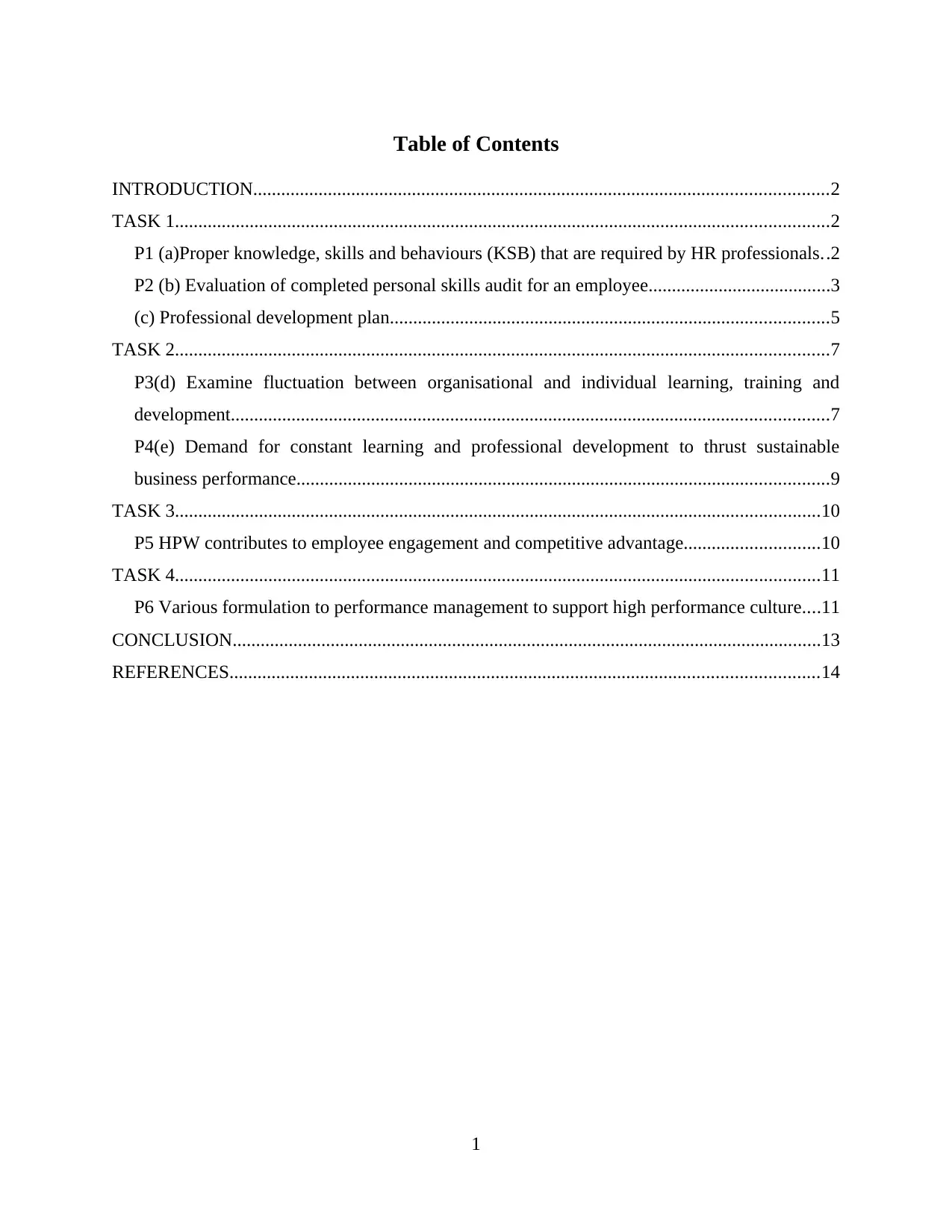
Table of Contents
INTRODUCTION...........................................................................................................................2
TASK 1............................................................................................................................................2
P1 (a)Proper knowledge, skills and behaviours (KSB) that are required by HR professionals..2
P2 (b) Evaluation of completed personal skills audit for an employee.......................................3
(c) Professional development plan..............................................................................................5
TASK 2............................................................................................................................................7
P3(d) Examine fluctuation between organisational and individual learning, training and
development................................................................................................................................7
P4(e) Demand for constant learning and professional development to thrust sustainable
business performance..................................................................................................................9
TASK 3..........................................................................................................................................10
P5 HPW contributes to employee engagement and competitive advantage.............................10
TASK 4..........................................................................................................................................11
P6 Various formulation to performance management to support high performance culture....11
CONCLUSION..............................................................................................................................13
REFERENCES..............................................................................................................................14
1
INTRODUCTION...........................................................................................................................2
TASK 1............................................................................................................................................2
P1 (a)Proper knowledge, skills and behaviours (KSB) that are required by HR professionals..2
P2 (b) Evaluation of completed personal skills audit for an employee.......................................3
(c) Professional development plan..............................................................................................5
TASK 2............................................................................................................................................7
P3(d) Examine fluctuation between organisational and individual learning, training and
development................................................................................................................................7
P4(e) Demand for constant learning and professional development to thrust sustainable
business performance..................................................................................................................9
TASK 3..........................................................................................................................................10
P5 HPW contributes to employee engagement and competitive advantage.............................10
TASK 4..........................................................................................................................................11
P6 Various formulation to performance management to support high performance culture....11
CONCLUSION..............................................................................................................................13
REFERENCES..............................................................................................................................14
1
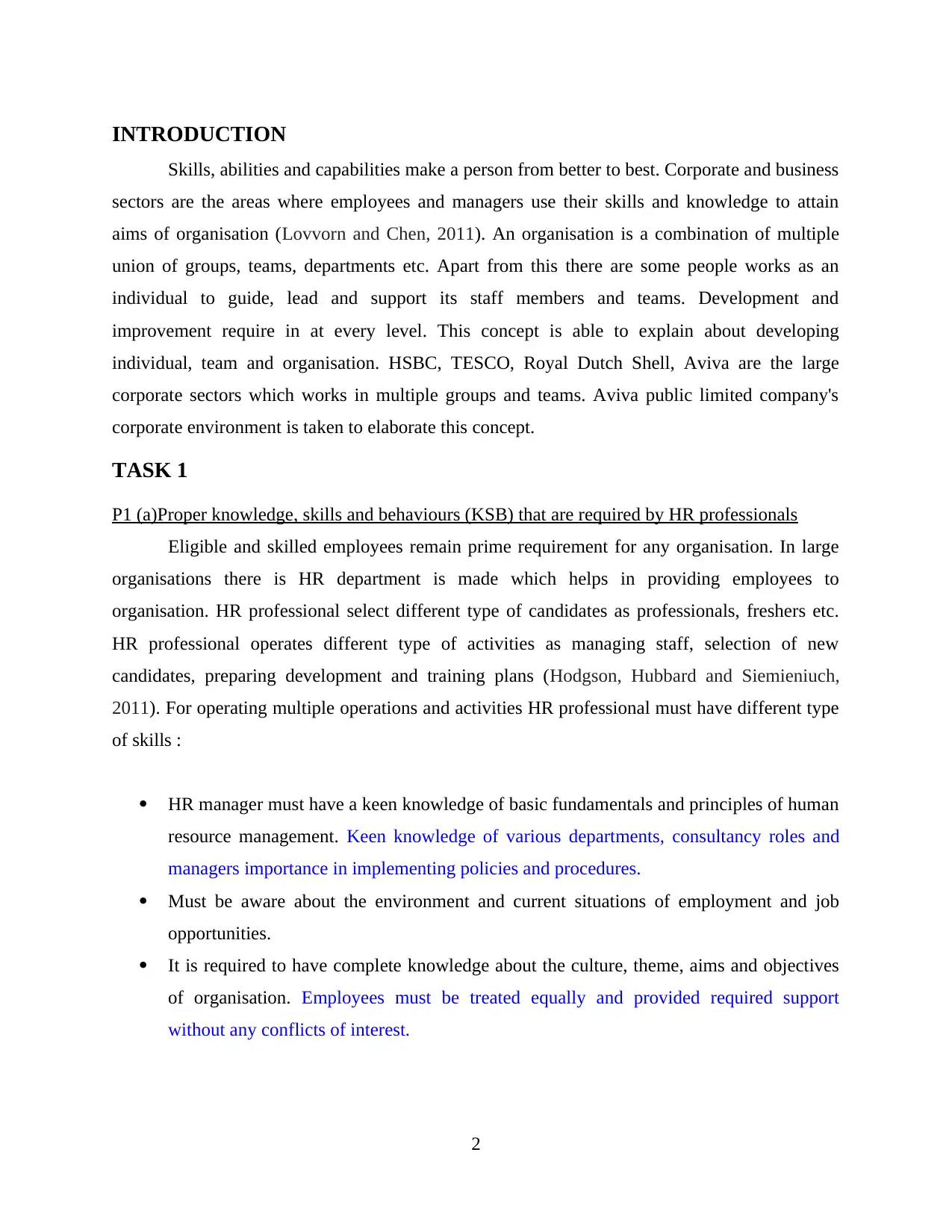
INTRODUCTION
Skills, abilities and capabilities make a person from better to best. Corporate and business
sectors are the areas where employees and managers use their skills and knowledge to attain
aims of organisation (Lovvorn and Chen, 2011). An organisation is a combination of multiple
union of groups, teams, departments etc. Apart from this there are some people works as an
individual to guide, lead and support its staff members and teams. Development and
improvement require in at every level. This concept is able to explain about developing
individual, team and organisation. HSBC, TESCO, Royal Dutch Shell, Aviva are the large
corporate sectors which works in multiple groups and teams. Aviva public limited company's
corporate environment is taken to elaborate this concept.
TASK 1
P1 (a)Proper knowledge, skills and behaviours (KSB) that are required by HR professionals
Eligible and skilled employees remain prime requirement for any organisation. In large
organisations there is HR department is made which helps in providing employees to
organisation. HR professional select different type of candidates as professionals, freshers etc.
HR professional operates different type of activities as managing staff, selection of new
candidates, preparing development and training plans (Hodgson, Hubbard and Siemieniuch,
2011). For operating multiple operations and activities HR professional must have different type
of skills :
HR manager must have a keen knowledge of basic fundamentals and principles of human
resource management. Keen knowledge of various departments, consultancy roles and
managers importance in implementing policies and procedures.
Must be aware about the environment and current situations of employment and job
opportunities.
It is required to have complete knowledge about the culture, theme, aims and objectives
of organisation. Employees must be treated equally and provided required support
without any conflicts of interest.
2
Skills, abilities and capabilities make a person from better to best. Corporate and business
sectors are the areas where employees and managers use their skills and knowledge to attain
aims of organisation (Lovvorn and Chen, 2011). An organisation is a combination of multiple
union of groups, teams, departments etc. Apart from this there are some people works as an
individual to guide, lead and support its staff members and teams. Development and
improvement require in at every level. This concept is able to explain about developing
individual, team and organisation. HSBC, TESCO, Royal Dutch Shell, Aviva are the large
corporate sectors which works in multiple groups and teams. Aviva public limited company's
corporate environment is taken to elaborate this concept.
TASK 1
P1 (a)Proper knowledge, skills and behaviours (KSB) that are required by HR professionals
Eligible and skilled employees remain prime requirement for any organisation. In large
organisations there is HR department is made which helps in providing employees to
organisation. HR professional select different type of candidates as professionals, freshers etc.
HR professional operates different type of activities as managing staff, selection of new
candidates, preparing development and training plans (Hodgson, Hubbard and Siemieniuch,
2011). For operating multiple operations and activities HR professional must have different type
of skills :
HR manager must have a keen knowledge of basic fundamentals and principles of human
resource management. Keen knowledge of various departments, consultancy roles and
managers importance in implementing policies and procedures.
Must be aware about the environment and current situations of employment and job
opportunities.
It is required to have complete knowledge about the culture, theme, aims and objectives
of organisation. Employees must be treated equally and provided required support
without any conflicts of interest.
2
⊘ This is a preview!⊘
Do you want full access?
Subscribe today to unlock all pages.

Trusted by 1+ million students worldwide
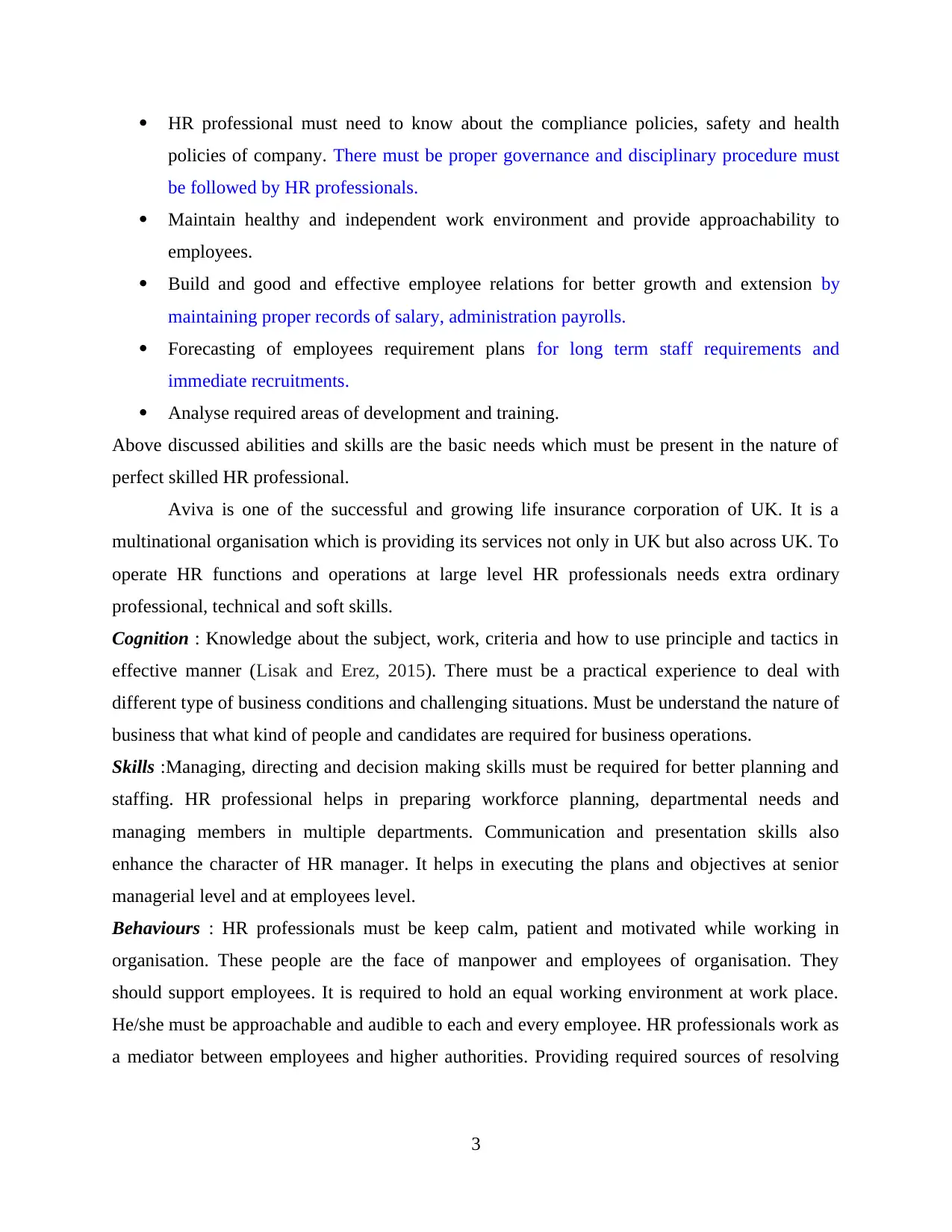
HR professional must need to know about the compliance policies, safety and health
policies of company. There must be proper governance and disciplinary procedure must
be followed by HR professionals.
Maintain healthy and independent work environment and provide approachability to
employees.
Build and good and effective employee relations for better growth and extension by
maintaining proper records of salary, administration payrolls.
Forecasting of employees requirement plans for long term staff requirements and
immediate recruitments.
Analyse required areas of development and training.
Above discussed abilities and skills are the basic needs which must be present in the nature of
perfect skilled HR professional.
Aviva is one of the successful and growing life insurance corporation of UK. It is a
multinational organisation which is providing its services not only in UK but also across UK. To
operate HR functions and operations at large level HR professionals needs extra ordinary
professional, technical and soft skills.
Cognition : Knowledge about the subject, work, criteria and how to use principle and tactics in
effective manner (Lisak and Erez, 2015). There must be a practical experience to deal with
different type of business conditions and challenging situations. Must be understand the nature of
business that what kind of people and candidates are required for business operations.
Skills :Managing, directing and decision making skills must be required for better planning and
staffing. HR professional helps in preparing workforce planning, departmental needs and
managing members in multiple departments. Communication and presentation skills also
enhance the character of HR manager. It helps in executing the plans and objectives at senior
managerial level and at employees level.
Behaviours : HR professionals must be keep calm, patient and motivated while working in
organisation. These people are the face of manpower and employees of organisation. They
should support employees. It is required to hold an equal working environment at work place.
He/she must be approachable and audible to each and every employee. HR professionals work as
a mediator between employees and higher authorities. Providing required sources of resolving
3
policies of company. There must be proper governance and disciplinary procedure must
be followed by HR professionals.
Maintain healthy and independent work environment and provide approachability to
employees.
Build and good and effective employee relations for better growth and extension by
maintaining proper records of salary, administration payrolls.
Forecasting of employees requirement plans for long term staff requirements and
immediate recruitments.
Analyse required areas of development and training.
Above discussed abilities and skills are the basic needs which must be present in the nature of
perfect skilled HR professional.
Aviva is one of the successful and growing life insurance corporation of UK. It is a
multinational organisation which is providing its services not only in UK but also across UK. To
operate HR functions and operations at large level HR professionals needs extra ordinary
professional, technical and soft skills.
Cognition : Knowledge about the subject, work, criteria and how to use principle and tactics in
effective manner (Lisak and Erez, 2015). There must be a practical experience to deal with
different type of business conditions and challenging situations. Must be understand the nature of
business that what kind of people and candidates are required for business operations.
Skills :Managing, directing and decision making skills must be required for better planning and
staffing. HR professional helps in preparing workforce planning, departmental needs and
managing members in multiple departments. Communication and presentation skills also
enhance the character of HR manager. It helps in executing the plans and objectives at senior
managerial level and at employees level.
Behaviours : HR professionals must be keep calm, patient and motivated while working in
organisation. These people are the face of manpower and employees of organisation. They
should support employees. It is required to hold an equal working environment at work place.
He/she must be approachable and audible to each and every employee. HR professionals work as
a mediator between employees and higher authorities. Providing required sources of resolving
3
Paraphrase This Document
Need a fresh take? Get an instant paraphrase of this document with our AI Paraphraser
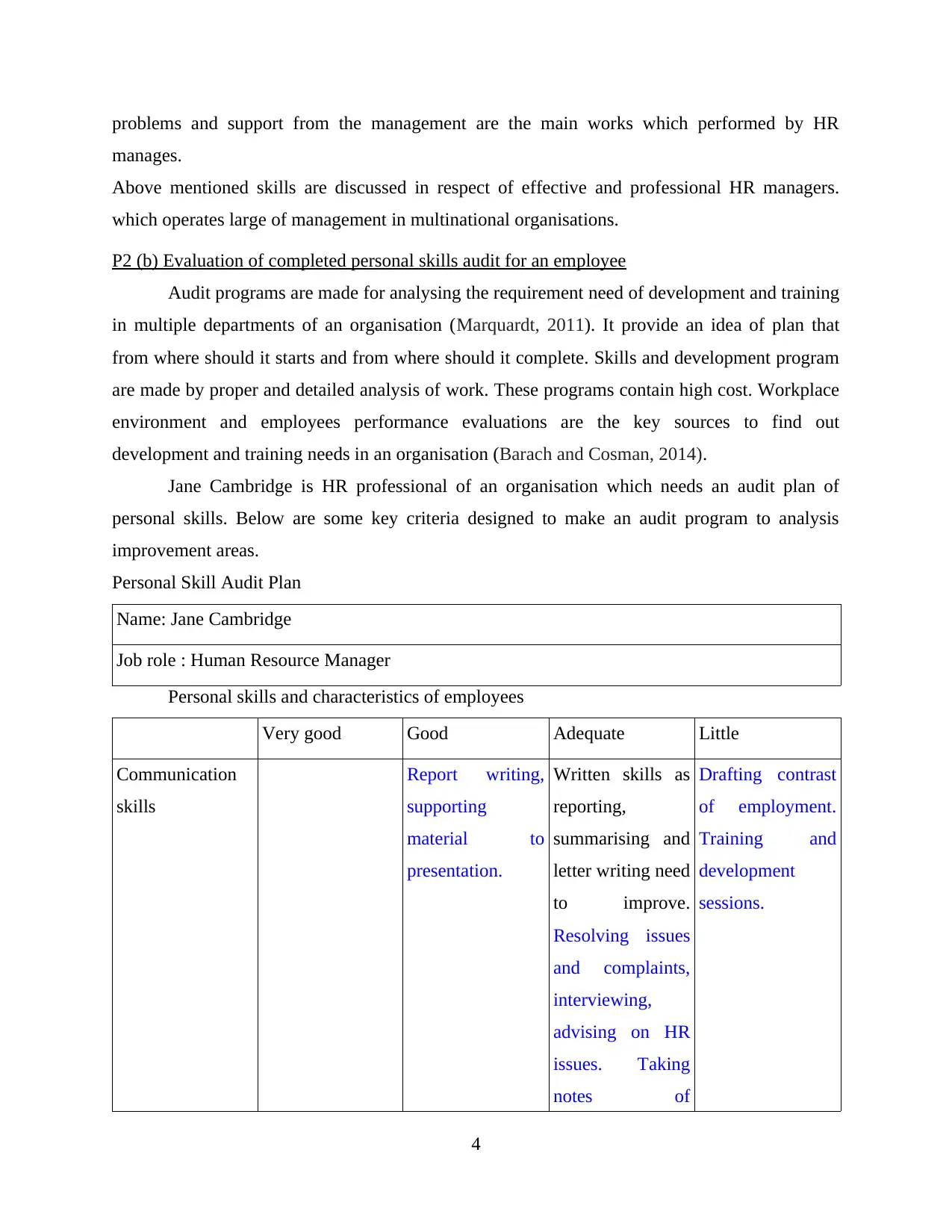
problems and support from the management are the main works which performed by HR
manages.
Above mentioned skills are discussed in respect of effective and professional HR managers.
which operates large of management in multinational organisations.
P2 (b) Evaluation of completed personal skills audit for an employee
Audit programs are made for analysing the requirement need of development and training
in multiple departments of an organisation (Marquardt, 2011). It provide an idea of plan that
from where should it starts and from where should it complete. Skills and development program
are made by proper and detailed analysis of work. These programs contain high cost. Workplace
environment and employees performance evaluations are the key sources to find out
development and training needs in an organisation (Barach and Cosman, 2014).
Jane Cambridge is HR professional of an organisation which needs an audit plan of
personal skills. Below are some key criteria designed to make an audit program to analysis
improvement areas.
Personal Skill Audit Plan
Name: Jane Cambridge
Job role : Human Resource Manager
Personal skills and characteristics of employees
Very good Good Adequate Little
Communication
skills
Report writing,
supporting
material to
presentation.
Written skills as
reporting,
summarising and
letter writing need
to improve.
Resolving issues
and complaints,
interviewing,
advising on HR
issues. Taking
notes of
Drafting contrast
of employment.
Training and
development
sessions.
4
manages.
Above mentioned skills are discussed in respect of effective and professional HR managers.
which operates large of management in multinational organisations.
P2 (b) Evaluation of completed personal skills audit for an employee
Audit programs are made for analysing the requirement need of development and training
in multiple departments of an organisation (Marquardt, 2011). It provide an idea of plan that
from where should it starts and from where should it complete. Skills and development program
are made by proper and detailed analysis of work. These programs contain high cost. Workplace
environment and employees performance evaluations are the key sources to find out
development and training needs in an organisation (Barach and Cosman, 2014).
Jane Cambridge is HR professional of an organisation which needs an audit plan of
personal skills. Below are some key criteria designed to make an audit program to analysis
improvement areas.
Personal Skill Audit Plan
Name: Jane Cambridge
Job role : Human Resource Manager
Personal skills and characteristics of employees
Very good Good Adequate Little
Communication
skills
Report writing,
supporting
material to
presentation.
Written skills as
reporting,
summarising and
letter writing need
to improve.
Resolving issues
and complaints,
interviewing,
advising on HR
issues. Taking
notes of
Drafting contrast
of employment.
Training and
development
sessions.
4
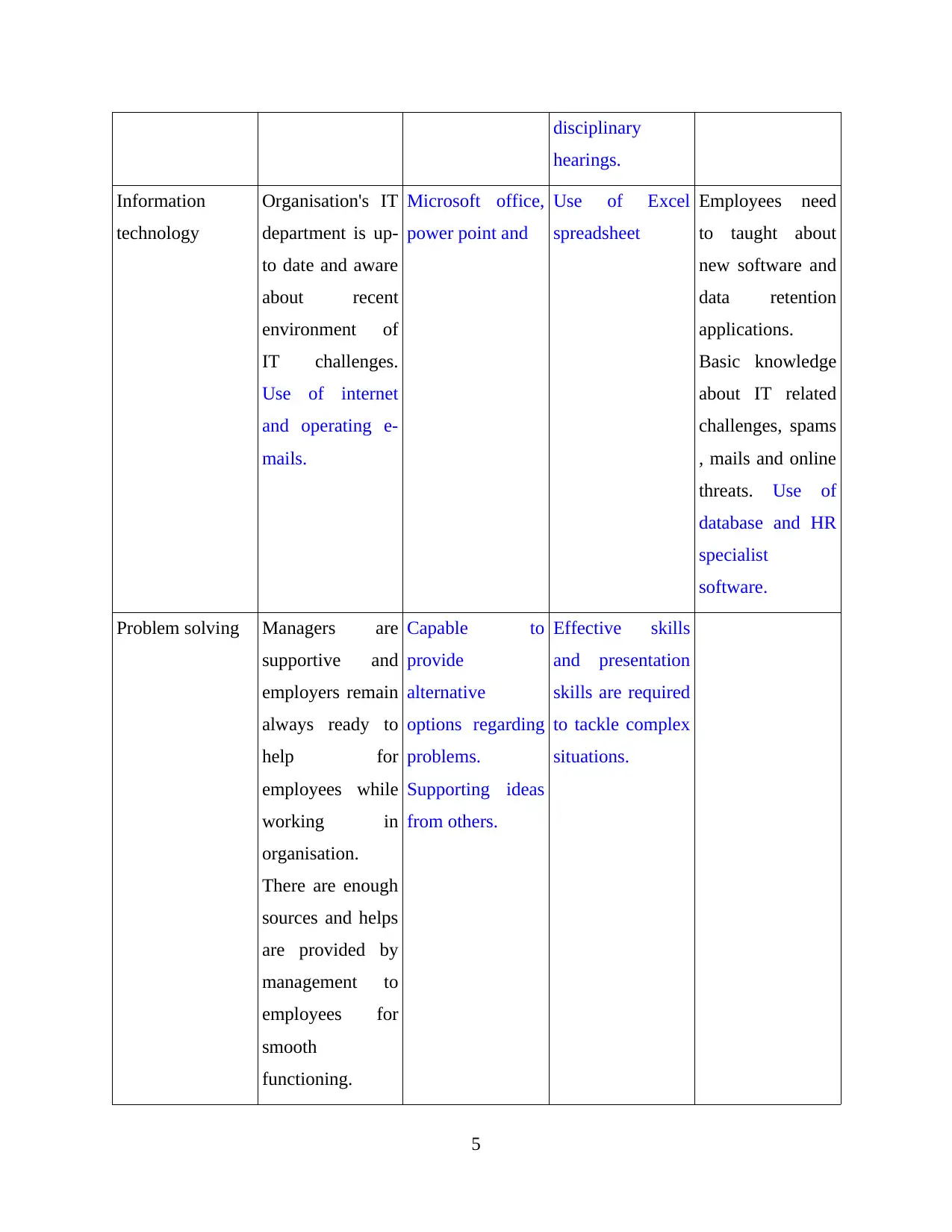
disciplinary
hearings.
Information
technology
Organisation's IT
department is up-
to date and aware
about recent
environment of
IT challenges.
Use of internet
and operating e-
mails.
Microsoft office,
power point and
Use of Excel
spreadsheet
Employees need
to taught about
new software and
data retention
applications.
Basic knowledge
about IT related
challenges, spams
, mails and online
threats. Use of
database and HR
specialist
software.
Problem solving Managers are
supportive and
employers remain
always ready to
help for
employees while
working in
organisation.
There are enough
sources and helps
are provided by
management to
employees for
smooth
functioning.
Capable to
provide
alternative
options regarding
problems.
Supporting ideas
from others.
Effective skills
and presentation
skills are required
to tackle complex
situations.
5
hearings.
Information
technology
Organisation's IT
department is up-
to date and aware
about recent
environment of
IT challenges.
Use of internet
and operating e-
mails.
Microsoft office,
power point and
Use of Excel
spreadsheet
Employees need
to taught about
new software and
data retention
applications.
Basic knowledge
about IT related
challenges, spams
, mails and online
threats. Use of
database and HR
specialist
software.
Problem solving Managers are
supportive and
employers remain
always ready to
help for
employees while
working in
organisation.
There are enough
sources and helps
are provided by
management to
employees for
smooth
functioning.
Capable to
provide
alternative
options regarding
problems.
Supporting ideas
from others.
Effective skills
and presentation
skills are required
to tackle complex
situations.
5
⊘ This is a preview!⊘
Do you want full access?
Subscribe today to unlock all pages.

Trusted by 1+ million students worldwide
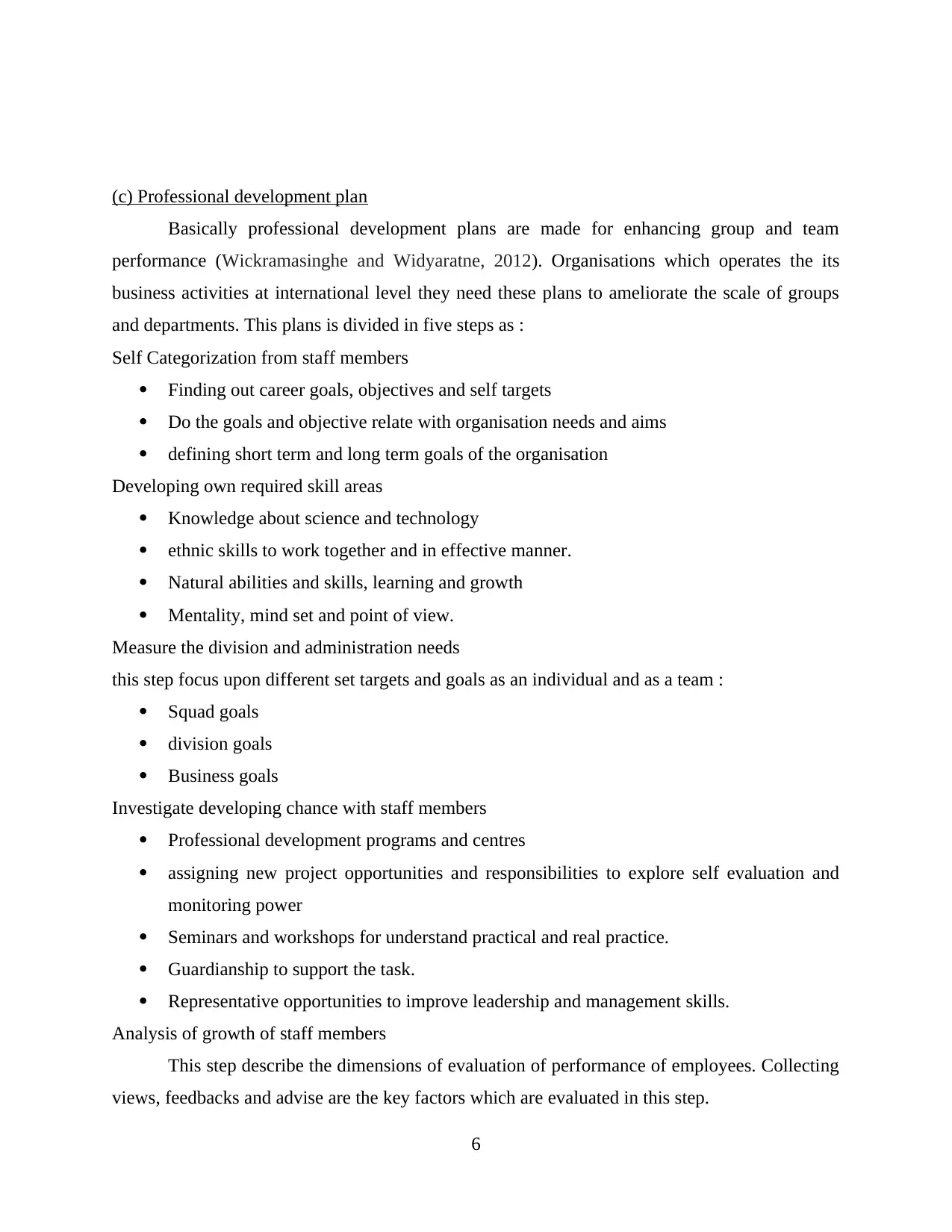
(c) Professional development plan
Basically professional development plans are made for enhancing group and team
performance (Wickramasinghe and Widyaratne, 2012). Organisations which operates the its
business activities at international level they need these plans to ameliorate the scale of groups
and departments. This plans is divided in five steps as :
Self Categorization from staff members
Finding out career goals, objectives and self targets
Do the goals and objective relate with organisation needs and aims
defining short term and long term goals of the organisation
Developing own required skill areas
Knowledge about science and technology
ethnic skills to work together and in effective manner.
Natural abilities and skills, learning and growth
Mentality, mind set and point of view.
Measure the division and administration needs
this step focus upon different set targets and goals as an individual and as a team :
Squad goals
division goals
Business goals
Investigate developing chance with staff members
Professional development programs and centres
assigning new project opportunities and responsibilities to explore self evaluation and
monitoring power
Seminars and workshops for understand practical and real practice.
Guardianship to support the task.
Representative opportunities to improve leadership and management skills.
Analysis of growth of staff members
This step describe the dimensions of evaluation of performance of employees. Collecting
views, feedbacks and advise are the key factors which are evaluated in this step.
6
Basically professional development plans are made for enhancing group and team
performance (Wickramasinghe and Widyaratne, 2012). Organisations which operates the its
business activities at international level they need these plans to ameliorate the scale of groups
and departments. This plans is divided in five steps as :
Self Categorization from staff members
Finding out career goals, objectives and self targets
Do the goals and objective relate with organisation needs and aims
defining short term and long term goals of the organisation
Developing own required skill areas
Knowledge about science and technology
ethnic skills to work together and in effective manner.
Natural abilities and skills, learning and growth
Mentality, mind set and point of view.
Measure the division and administration needs
this step focus upon different set targets and goals as an individual and as a team :
Squad goals
division goals
Business goals
Investigate developing chance with staff members
Professional development programs and centres
assigning new project opportunities and responsibilities to explore self evaluation and
monitoring power
Seminars and workshops for understand practical and real practice.
Guardianship to support the task.
Representative opportunities to improve leadership and management skills.
Analysis of growth of staff members
This step describe the dimensions of evaluation of performance of employees. Collecting
views, feedbacks and advise are the key factors which are evaluated in this step.
6
Paraphrase This Document
Need a fresh take? Get an instant paraphrase of this document with our AI Paraphraser
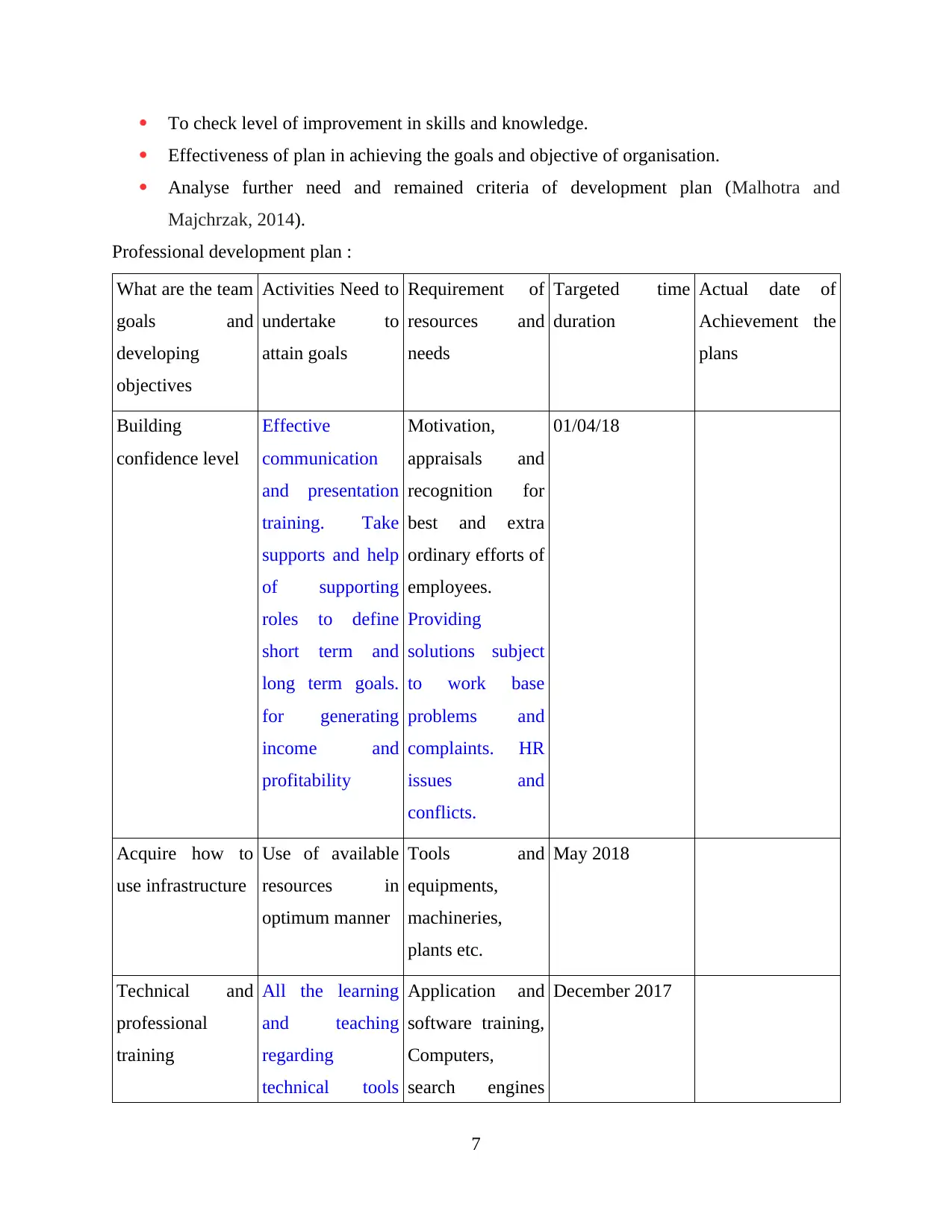
To check level of improvement in skills and knowledge.
Effectiveness of plan in achieving the goals and objective of organisation.
Analyse further need and remained criteria of development plan (Malhotra and
Majchrzak, 2014).
Professional development plan :
What are the team
goals and
developing
objectives
Activities Need to
undertake to
attain goals
Requirement of
resources and
needs
Targeted time
duration
Actual date of
Achievement the
plans
Building
confidence level
Effective
communication
and presentation
training. Take
supports and help
of supporting
roles to define
short term and
long term goals.
for generating
income and
profitability
Motivation,
appraisals and
recognition for
best and extra
ordinary efforts of
employees.
Providing
solutions subject
to work base
problems and
complaints. HR
issues and
conflicts.
01/04/18
Acquire how to
use infrastructure
Use of available
resources in
optimum manner
Tools and
equipments,
machineries,
plants etc.
May 2018
Technical and
professional
training
All the learning
and teaching
regarding
technical tools
Application and
software training,
Computers,
search engines
December 2017
7
Effectiveness of plan in achieving the goals and objective of organisation.
Analyse further need and remained criteria of development plan (Malhotra and
Majchrzak, 2014).
Professional development plan :
What are the team
goals and
developing
objectives
Activities Need to
undertake to
attain goals
Requirement of
resources and
needs
Targeted time
duration
Actual date of
Achievement the
plans
Building
confidence level
Effective
communication
and presentation
training. Take
supports and help
of supporting
roles to define
short term and
long term goals.
for generating
income and
profitability
Motivation,
appraisals and
recognition for
best and extra
ordinary efforts of
employees.
Providing
solutions subject
to work base
problems and
complaints. HR
issues and
conflicts.
01/04/18
Acquire how to
use infrastructure
Use of available
resources in
optimum manner
Tools and
equipments,
machineries,
plants etc.
May 2018
Technical and
professional
training
All the learning
and teaching
regarding
technical tools
Application and
software training,
Computers,
search engines
December 2017
7
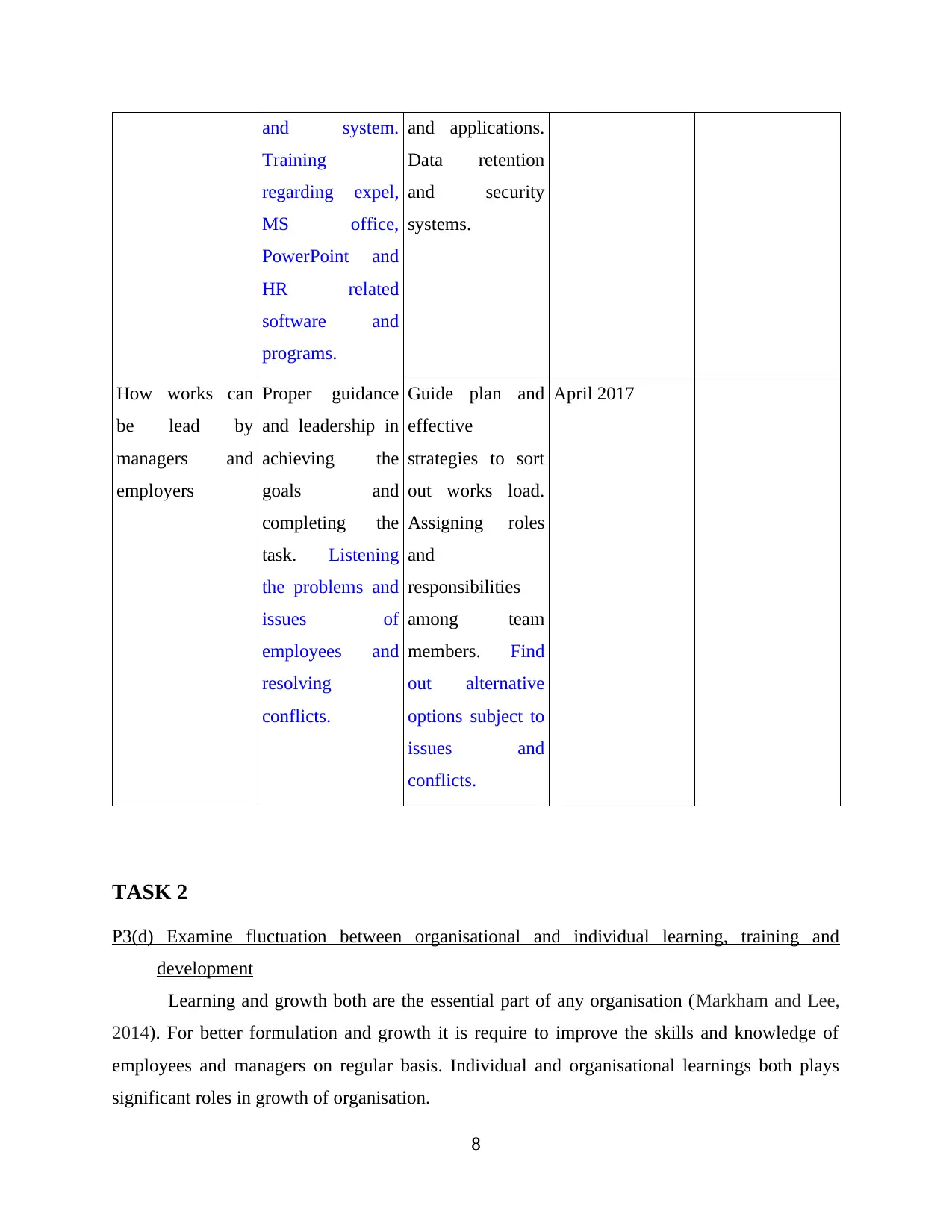
and system.
Training
regarding expel,
MS office,
PowerPoint and
HR related
software and
programs.
and applications.
Data retention
and security
systems.
How works can
be lead by
managers and
employers
Proper guidance
and leadership in
achieving the
goals and
completing the
task. Listening
the problems and
issues of
employees and
resolving
conflicts.
Guide plan and
effective
strategies to sort
out works load.
Assigning roles
and
responsibilities
among team
members. Find
out alternative
options subject to
issues and
conflicts.
April 2017
TASK 2
P3(d) Examine fluctuation between organisational and individual learning, training and
development
Learning and growth both are the essential part of any organisation (Markham and Lee,
2014). For better formulation and growth it is require to improve the skills and knowledge of
employees and managers on regular basis. Individual and organisational learnings both plays
significant roles in growth of organisation.
8
Training
regarding expel,
MS office,
PowerPoint and
HR related
software and
programs.
and applications.
Data retention
and security
systems.
How works can
be lead by
managers and
employers
Proper guidance
and leadership in
achieving the
goals and
completing the
task. Listening
the problems and
issues of
employees and
resolving
conflicts.
Guide plan and
effective
strategies to sort
out works load.
Assigning roles
and
responsibilities
among team
members. Find
out alternative
options subject to
issues and
conflicts.
April 2017
TASK 2
P3(d) Examine fluctuation between organisational and individual learning, training and
development
Learning and growth both are the essential part of any organisation (Markham and Lee,
2014). For better formulation and growth it is require to improve the skills and knowledge of
employees and managers on regular basis. Individual and organisational learnings both plays
significant roles in growth of organisation.
8
⊘ This is a preview!⊘
Do you want full access?
Subscribe today to unlock all pages.

Trusted by 1+ million students worldwide
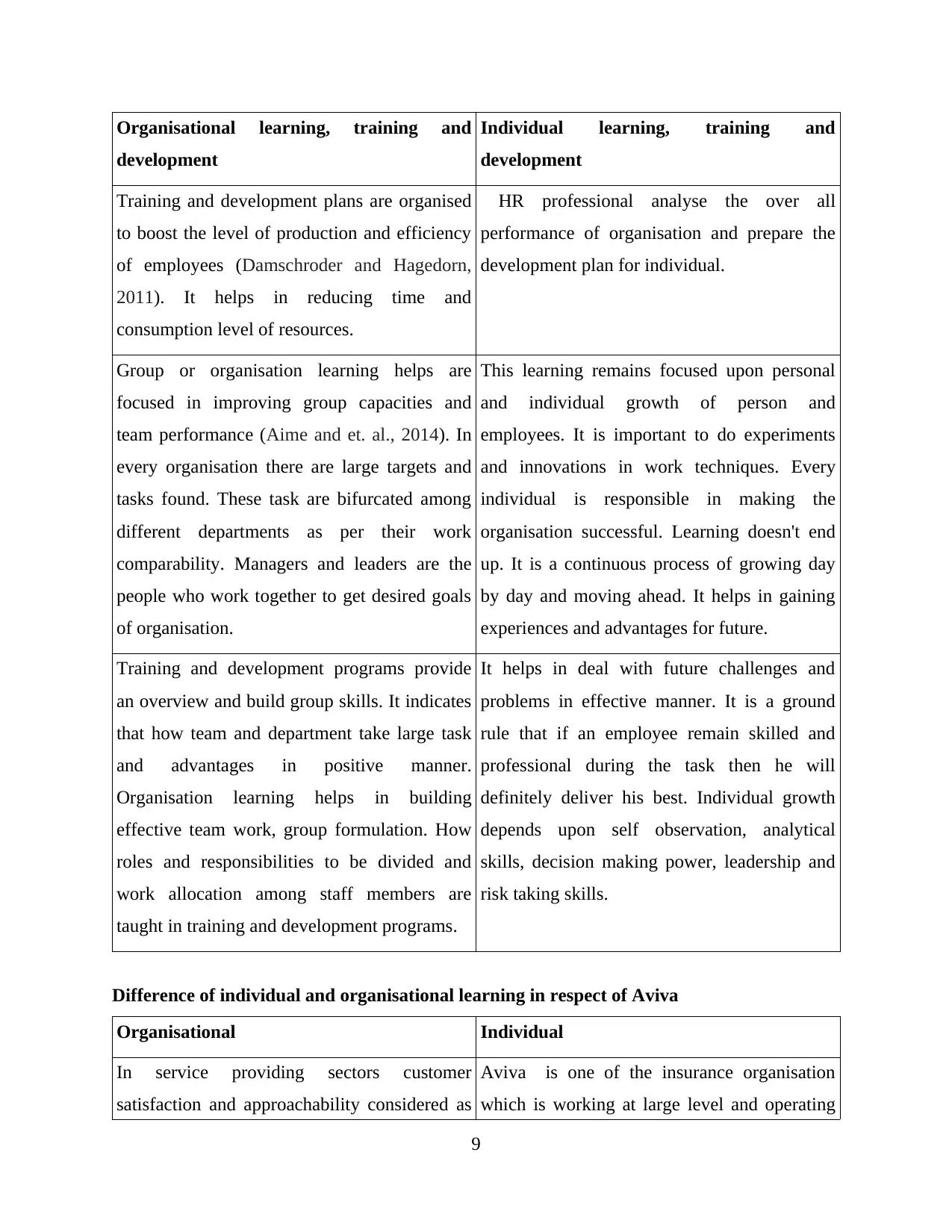
Organisational learning, training and
development
Individual learning, training and
development
Training and development plans are organised
to boost the level of production and efficiency
of employees (Damschroder and Hagedorn,
2011). It helps in reducing time and
consumption level of resources.
HR professional analyse the over all
performance of organisation and prepare the
development plan for individual.
Group or organisation learning helps are
focused in improving group capacities and
team performance (Aime and et. al., 2014). In
every organisation there are large targets and
tasks found. These task are bifurcated among
different departments as per their work
comparability. Managers and leaders are the
people who work together to get desired goals
of organisation.
This learning remains focused upon personal
and individual growth of person and
employees. It is important to do experiments
and innovations in work techniques. Every
individual is responsible in making the
organisation successful. Learning doesn't end
up. It is a continuous process of growing day
by day and moving ahead. It helps in gaining
experiences and advantages for future.
Training and development programs provide
an overview and build group skills. It indicates
that how team and department take large task
and advantages in positive manner.
Organisation learning helps in building
effective team work, group formulation. How
roles and responsibilities to be divided and
work allocation among staff members are
taught in training and development programs.
It helps in deal with future challenges and
problems in effective manner. It is a ground
rule that if an employee remain skilled and
professional during the task then he will
definitely deliver his best. Individual growth
depends upon self observation, analytical
skills, decision making power, leadership and
risk taking skills.
Difference of individual and organisational learning in respect of Aviva
Organisational Individual
In service providing sectors customer
satisfaction and approachability considered as
Aviva is one of the insurance organisation
which is working at large level and operating
9
development
Individual learning, training and
development
Training and development plans are organised
to boost the level of production and efficiency
of employees (Damschroder and Hagedorn,
2011). It helps in reducing time and
consumption level of resources.
HR professional analyse the over all
performance of organisation and prepare the
development plan for individual.
Group or organisation learning helps are
focused in improving group capacities and
team performance (Aime and et. al., 2014). In
every organisation there are large targets and
tasks found. These task are bifurcated among
different departments as per their work
comparability. Managers and leaders are the
people who work together to get desired goals
of organisation.
This learning remains focused upon personal
and individual growth of person and
employees. It is important to do experiments
and innovations in work techniques. Every
individual is responsible in making the
organisation successful. Learning doesn't end
up. It is a continuous process of growing day
by day and moving ahead. It helps in gaining
experiences and advantages for future.
Training and development programs provide
an overview and build group skills. It indicates
that how team and department take large task
and advantages in positive manner.
Organisation learning helps in building
effective team work, group formulation. How
roles and responsibilities to be divided and
work allocation among staff members are
taught in training and development programs.
It helps in deal with future challenges and
problems in effective manner. It is a ground
rule that if an employee remain skilled and
professional during the task then he will
definitely deliver his best. Individual growth
depends upon self observation, analytical
skills, decision making power, leadership and
risk taking skills.
Difference of individual and organisational learning in respect of Aviva
Organisational Individual
In service providing sectors customer
satisfaction and approachability considered as
Aviva is one of the insurance organisation
which is working at large level and operating
9
Paraphrase This Document
Need a fresh take? Get an instant paraphrase of this document with our AI Paraphraser
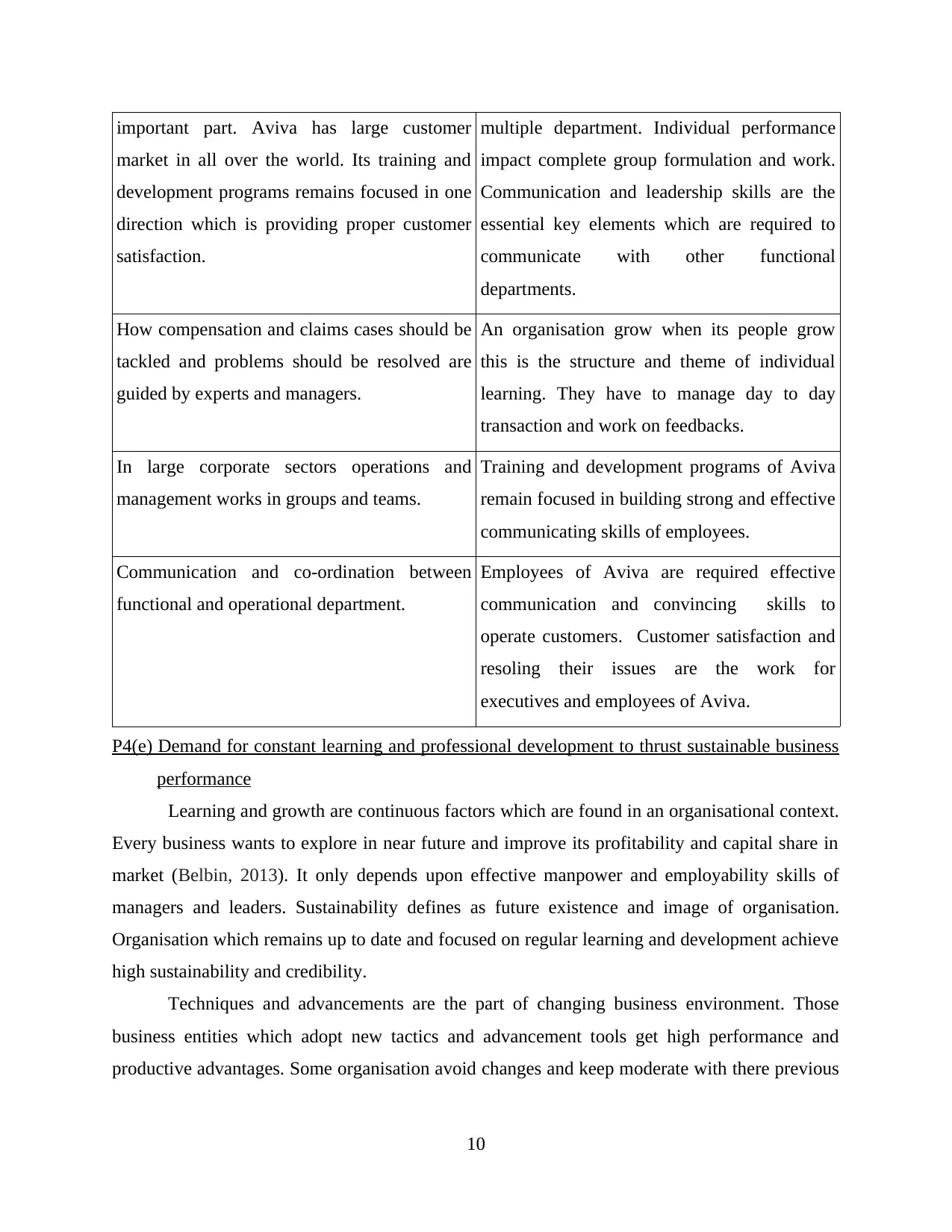
important part. Aviva has large customer
market in all over the world. Its training and
development programs remains focused in one
direction which is providing proper customer
satisfaction.
multiple department. Individual performance
impact complete group formulation and work.
Communication and leadership skills are the
essential key elements which are required to
communicate with other functional
departments.
How compensation and claims cases should be
tackled and problems should be resolved are
guided by experts and managers.
An organisation grow when its people grow
this is the structure and theme of individual
learning. They have to manage day to day
transaction and work on feedbacks.
In large corporate sectors operations and
management works in groups and teams.
Training and development programs of Aviva
remain focused in building strong and effective
communicating skills of employees.
Communication and co-ordination between
functional and operational department.
Employees of Aviva are required effective
communication and convincing skills to
operate customers. Customer satisfaction and
resoling their issues are the work for
executives and employees of Aviva.
P4(e) Demand for constant learning and professional development to thrust sustainable business
performance
Learning and growth are continuous factors which are found in an organisational context.
Every business wants to explore in near future and improve its profitability and capital share in
market (Belbin, 2013). It only depends upon effective manpower and employability skills of
managers and leaders. Sustainability defines as future existence and image of organisation.
Organisation which remains up to date and focused on regular learning and development achieve
high sustainability and credibility.
Techniques and advancements are the part of changing business environment. Those
business entities which adopt new tactics and advancement tools get high performance and
productive advantages. Some organisation avoid changes and keep moderate with there previous
10
market in all over the world. Its training and
development programs remains focused in one
direction which is providing proper customer
satisfaction.
multiple department. Individual performance
impact complete group formulation and work.
Communication and leadership skills are the
essential key elements which are required to
communicate with other functional
departments.
How compensation and claims cases should be
tackled and problems should be resolved are
guided by experts and managers.
An organisation grow when its people grow
this is the structure and theme of individual
learning. They have to manage day to day
transaction and work on feedbacks.
In large corporate sectors operations and
management works in groups and teams.
Training and development programs of Aviva
remain focused in building strong and effective
communicating skills of employees.
Communication and co-ordination between
functional and operational department.
Employees of Aviva are required effective
communication and convincing skills to
operate customers. Customer satisfaction and
resoling their issues are the work for
executives and employees of Aviva.
P4(e) Demand for constant learning and professional development to thrust sustainable business
performance
Learning and growth are continuous factors which are found in an organisational context.
Every business wants to explore in near future and improve its profitability and capital share in
market (Belbin, 2013). It only depends upon effective manpower and employability skills of
managers and leaders. Sustainability defines as future existence and image of organisation.
Organisation which remains up to date and focused on regular learning and development achieve
high sustainability and credibility.
Techniques and advancements are the part of changing business environment. Those
business entities which adopt new tactics and advancement tools get high performance and
productive advantages. Some organisation avoid changes and keep moderate with there previous
10
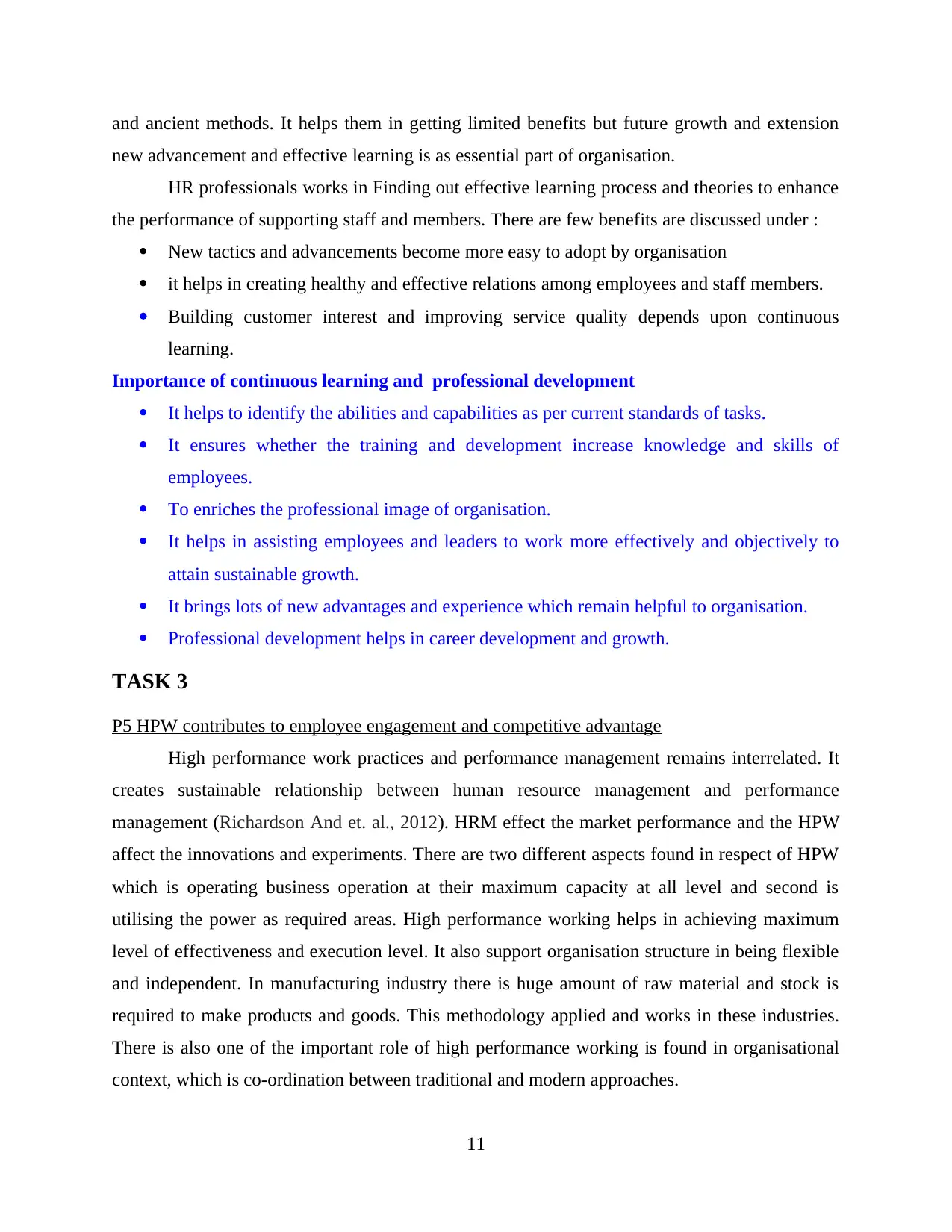
and ancient methods. It helps them in getting limited benefits but future growth and extension
new advancement and effective learning is as essential part of organisation.
HR professionals works in Finding out effective learning process and theories to enhance
the performance of supporting staff and members. There are few benefits are discussed under :
New tactics and advancements become more easy to adopt by organisation
it helps in creating healthy and effective relations among employees and staff members.
Building customer interest and improving service quality depends upon continuous
learning.
Importance of continuous learning and professional development
It helps to identify the abilities and capabilities as per current standards of tasks.
It ensures whether the training and development increase knowledge and skills of
employees.
To enriches the professional image of organisation.
It helps in assisting employees and leaders to work more effectively and objectively to
attain sustainable growth.
It brings lots of new advantages and experience which remain helpful to organisation.
Professional development helps in career development and growth.
TASK 3
P5 HPW contributes to employee engagement and competitive advantage
High performance work practices and performance management remains interrelated. It
creates sustainable relationship between human resource management and performance
management (Richardson And et. al., 2012). HRM effect the market performance and the HPW
affect the innovations and experiments. There are two different aspects found in respect of HPW
which is operating business operation at their maximum capacity at all level and second is
utilising the power as required areas. High performance working helps in achieving maximum
level of effectiveness and execution level. It also support organisation structure in being flexible
and independent. In manufacturing industry there is huge amount of raw material and stock is
required to make products and goods. This methodology applied and works in these industries.
There is also one of the important role of high performance working is found in organisational
context, which is co-ordination between traditional and modern approaches.
11
new advancement and effective learning is as essential part of organisation.
HR professionals works in Finding out effective learning process and theories to enhance
the performance of supporting staff and members. There are few benefits are discussed under :
New tactics and advancements become more easy to adopt by organisation
it helps in creating healthy and effective relations among employees and staff members.
Building customer interest and improving service quality depends upon continuous
learning.
Importance of continuous learning and professional development
It helps to identify the abilities and capabilities as per current standards of tasks.
It ensures whether the training and development increase knowledge and skills of
employees.
To enriches the professional image of organisation.
It helps in assisting employees and leaders to work more effectively and objectively to
attain sustainable growth.
It brings lots of new advantages and experience which remain helpful to organisation.
Professional development helps in career development and growth.
TASK 3
P5 HPW contributes to employee engagement and competitive advantage
High performance work practices and performance management remains interrelated. It
creates sustainable relationship between human resource management and performance
management (Richardson And et. al., 2012). HRM effect the market performance and the HPW
affect the innovations and experiments. There are two different aspects found in respect of HPW
which is operating business operation at their maximum capacity at all level and second is
utilising the power as required areas. High performance working helps in achieving maximum
level of effectiveness and execution level. It also support organisation structure in being flexible
and independent. In manufacturing industry there is huge amount of raw material and stock is
required to make products and goods. This methodology applied and works in these industries.
There is also one of the important role of high performance working is found in organisational
context, which is co-ordination between traditional and modern approaches.
11
⊘ This is a preview!⊘
Do you want full access?
Subscribe today to unlock all pages.

Trusted by 1+ million students worldwide
1 out of 18
Related Documents
Your All-in-One AI-Powered Toolkit for Academic Success.
+13062052269
info@desklib.com
Available 24*7 on WhatsApp / Email
![[object Object]](/_next/static/media/star-bottom.7253800d.svg)
Unlock your academic potential
Copyright © 2020–2025 A2Z Services. All Rights Reserved. Developed and managed by ZUCOL.





